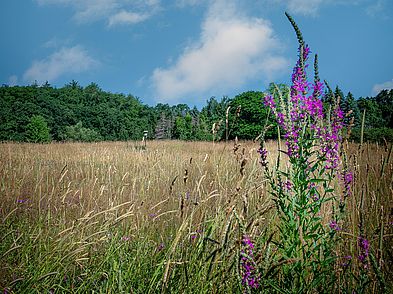Hans Morris Reservation
Rare Grassland Habitat, Abuts Wildlife Corridor
An expansive meadow bustling with grassland birds welcomes you to a mixed wood forest, bordered by wetlands that provide habitat for beavers and waterfowl.
Por favor, espere, el mapa se está cargando.
Location, Directions & Parking
- Middle Road, Newbury (Opens in Google Maps)
Park on the side of the road.
Beyond the stone wall, trails through a wooded upland lead to a boardwalk and wetlands that abut the Martin Burns Wildlife Management Area.
Prior to English colonization this was a wooded area. In times past Indigenous peoples would have harvested fibers from the sedges and rushes growing along the stream to twist into cordage.
They would have netted migratory birds in the spring and hunted turkeys, ducks, and geese during the fall fowling season. To snare large birds taking flight the people threw bolas—three or four small stones attached to cords with the ends secured in one knot. The device entangled the birds legs to bring it down without harming the feathers, which were as important to Indigenous people as the meat.
During the late 18th and early 19th centuries, approximately 80 percent of Massachusetts’ forests were cleared for agriculture. The hayfields and pastures provided sanctuary to birds, insects and small animals until the farms were abandoned, and land began to revert back to forest. To prevent the loss of this meadow to successional forest, Greenbelt actively manages the property for grassland birds, mowing the field after the nesting season is completed in July.
John Morris enjoyed exploring nature on his Newbury property with his children and grandchildren. Hans Morris Reservation opened in 2011, and is named for John’s grandson to encourage future generations of young people to experience the joys of the outdoors.
A meandering stream through wetlands dominated by sedges and rushes separates the grasslands from a mixed hardwood/conifer forest. Wildflowers abound from late May through June.
The superb grassland habitat attracts invertebrates, including dragonflies, butterflies, and damselflies. Bobolinks and eastern meadowlarks are known to nest successfully in June and July, and eastern wild turkeys are common all year. The large beaver-flooded wetland attracts wood ducks and other waterfowl.
Get GreenbeltGo Trails App
Land Acknowledgment
The properties that Greenbelt conserves are on the ancestral lands of the Pennacook and the Pawtucket, bands of Abenaki-speaking people. Join us in honoring the elders who lived here before, the Indigenous descendants today and the generations to come. Learn more…



